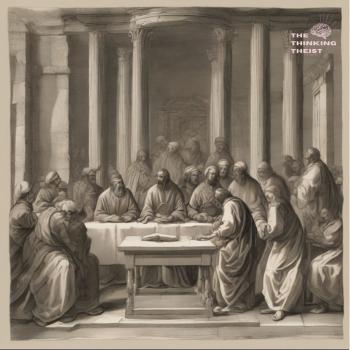Below are some notes for an introductory lecture on Christology.
INTRODUCTION
Christology is frequently divided into two sections, the first dealing with the person of Christ and the second dealing with the work of Christ. That division is far from sharp; Jesus?Ework depends on Jesus?Eidentity. But I will accept this division for the moment to simplify the presentation. Later, I hope to complexify things again. In this lecture, I’ll concentrate on the Person of Christ.
PERSON OF CHRIST
There are two sets of issues regarding the Person of Christ: First, was Jesus the Eternal Son of the Father, consubstantial with Him? Second, assuming that Jesus was indeed the Eternal Son of the Father, how does that comport with the conclusion that Jesus was true man? How are divine and human related in Jesus?
Historically and theologically, these are not separable issues. We know the Eternal Son (as we know the Trinity) through the economy of redemption, so the question of Jesus?Erelation to God arises from the incarnation, which necessarily raises the question of the divine and human in Jesus. Arius and the Arians denied that Jesus was eternal God in part because they could not conceive of the eternal God suffering on the cross; their conception of the Son?s ?ontology?Ewas guided by their observation of the ?economy.?EIn a chapter on the Eternal Son (CD 1.1), Barth intriguingly classifies Christologies as ?Ebionite?Eor ?Docetic?E?Ethe former treating Jesus as the ?apotheosis of man?Eand the latter treating Jesus as the embodiment or personification of some Idea, such that the specific actions and character of Jesus of Nazareth are treated as an arbitrary husk that we discard to get to the nut. For the Docetist, the Savior could just as easily have been Jason of Athens as Jesus of Nazareth. The intriguing thing about this classification is that both of these theories were originally theories about Jesus, not about the Eternal Son as such, yet Barth uses them to discuss dogmatic errors regarding the Eternal Son. For Barth, of course, we have no knowledge of the ?Eternal Son as such,?Esince He reveals Himself as Jesus.
One way to emphasize that these issues are inseparable is by emphasizing the narrative shape of Christology, and of identity in general. One way to pinpoint the question of personal identity is to ask, Who is the subject of this biography? Within this context, the question of Christology is, ?Who is the subject of the story given in the gospels? Is the whole story the story of the Eternal Son living as man? Is the birth of Jesus part of the story of the Eternal Son in human flesh? Is His death? Or, alternatively, do the gospels perhaps tell two intertwined stories? At times (when He?s performing miracles, eg), Jesus acts in his divine capacity, but at other times His divinity takes a back seat and allows the human nature to function more or less independently (at His birth and death, or when He?s hungry)??EThe offense of the first alternative should not be minimized or overlooked. If we say that the subject of the story of the gospel is the Eternal Son living as man, then we have to say that the Eternal Son endured a human birth, the Eternal Son dirtied His diapers and cried for His mother?s breast, the Eternal Son got hungry and thirsty and tired, the Eternal Son died a shameful death on the cross. That is, of course, precisely what the Bible says. But the offense and difficulty of grasping this should not be ignored. It is no wonder that the church struggled mightily before she glimpsed the depth of His work for us.
WORD-FLESH/WORD-MAN
The great heresy regarding the first question was Arianism, which taught that Jesus was a high creature, at best some kind of second-class God.
The questions we want to examine here are in the second category. Again, it is important to realize that these are not really separable issues, but that any conception of the ?economic?Erelation of the divine and human assumes/implies some ?ontology?Eof the Son. J.N.D. Kelly employs two important phrases to describe the direction that Christology went in the early church. On the one hand (mainly in Alexandria), there were Word-flesh Christologies, which tended to maximize the confession that the Word of God was the subject of the story of Jesus and tended to minimize the full humanity of Jesus. The Son took on ?flesh,?Ebut not a full-fledged human nature. One heretical form of the Word-flesh Christology was Apollinarianism, which taught that the Logos/Son took the place of the ?hegemonic principle?Eof mind or soul in the human nature of Jesus. This was rejected because it implies that Jesus?Ehuman nature was not a complete human nature, and, according to the patristic formula, ?what is not assumed is not redeemed.?ESince it is the Eternal Son who acts in Jesus for salvation, Word-flesh Christologies are soteriologically monergistic. But they tend to minimize the historical Jesus, and can verge toward docetism. (David Wells points out that Luther tended strongly toward a Word-flesh Christology, which may lend some support to the idea recently developed among Finnish Lutherans that Luther taught a strong doctrine of deification.)
On the other side were Word-man Christologies, which tended to maximize the human nature of Jesus but minimize the fact that the Eternal Son was the subject of the story of Jesus. On the heretical margins, this could become an ?Adoptionist?EChristology, in which the Son inhabited an already-existing man (perhaps at his baptism). Word-man Christologies have a strong interest in the historical Jesus, but tend to be soteriologically synergistic and can tend toward Nestorianism.
CHALCEDON
Another way to approach this question is to work backward from the formula of Chalcedon (451), which established what became the (widely, though by no means not universally) accepted formula in Christology. That formula reads in part:
?Therefore, following the holy Fathers, we all with one accord teach men to acknowledge one and the same Son, our Lord Jesus Christ, at once complete in Godhead and complete in manhood, truly God and truly man, consisting also of a reasonable soul and body; of one substance with the Father as regards his Godhead, and at the same time of one substance with us as regards his manhood; like us in all respects, apart from sin; as regards his Godhead, begotten of the Father before the ages, but yet as regards his manhood begotten, for us men and for our salvation, of Mary the Virgin, the God-bearer; one and the same Christ, Son, Lord, Only-begotten, recognized in two natures, without confusion, without change, without division, without separation; the distinction of natures being in no way annulled by the union, but rather the characteristics of each nature being preserved and coming together to form one person and subsistence, not as parted or separated into two persons, but one and the same Son and Only-begotten God the Word, Lord Jesus Christ; even as the prophets from earliest times spoke of him, and our Lord Jesus Christ himself taught us, and the creed of the Fathers has handed down to us.?E
The history behind this formula will not concern us, and the relevant portion of the formula for our purposes is the ?two natures . . . but one and the same Son and Only-begotten God the Word,?Eas well as the series of negatives ?E?without confusion, without change, without division, without separation.?EEach of these phrases is a rejection of some heresy. Let?s look at the various statements.
?Monophysites?E(also known as ?Eutychians,?Eafter a monk named Eutyches) believed that after the incarnation there was only one nature (?physis?E in Jesus. The human nature was absorbed into the divine. The formula ?two natures, one person?Ewas an anti-monophysite statement, as was the formula ?without confusion.?EWilliam Placher puts it this way: If you ask ?what?EJesus was, you are asking a question of nature; Jesus is God and man. If you ask ?who?EJesus is, you are asking a que
stion of Person; Jesus is the Eternal Son of God incarnate.
On the other hand, Nestorians tended to treat the two natures of Jesus as separate. The controversy with Nestorius came to a head over the use of the phrase ?theotokos,?E?God-bearer,?Ea title given to Mary. The orthodox agreed that Mary had indeed borne God in her womb, and given birth to God, not in the sense that she became God?s creator but in the sense that the child she bore was the God the Eternal Son. The historical facts are confused, but whatever Nestorius himself believed, Nestorianism came to be seen as a Christology of separation. The human nature of Jesus has one biography, and the divine nature has a separate life story; the two intersect at various points, but also diverge at various points, so that some events of the life of Jesus are events only in the life of the man (birth, death). The orthodox insisted that the two natures were ?without separation.?EJesus had a single biography, and it was the biography of a single Person, the Son of God in human flesh. Orthodoxy thus insists that the union of the natures is ?hypostatic?E[in a single person], and that the human nature is ?anhypostatic?E[not a separate person]. The Logos is thus enhypostatic with reference to the human nature; the Son is the hypostasis of the human nature. As Barth emphasized, these apparently abstract terms are important for protecting the center of the gospel, namely, that the Lord came to save us. If Jesus is not the Eternal Son, but something other, then His work is not the work of the Lord.
It had long been believed that the properties of the two natures in Jesus were somehow shared. This doctrine is known as the ?communication of attributes?Eor the ?communication idiomatum.?EThough this is universally believed, there is a great deal of controversy, especially after the Reformation, concerning the precise character of this communication between natures. Lutherans and Reformed theologians differed on this sharply. Lutherans taught that the attributes of one nature were shared with the other nature; thus, Jesus?Ehuman nature took on the attribute of omnipresence. The Reformed, by contrast, taught that the natures are united in the One Person, and therefore it is permitted to speak of the One Person in both divine and human terms. For the Reformed, the human nature of Jesus does not take on the property of omnipresence, nor does thed divine nature take on the property of finitude; rather, we attribute omnipresent to Jesus, the Incarnate Son, because He is divine, and we attribute limits to the One Person because Jesus, the Incarnate Son, is human.
RELATIONALITY AND INCARNATION
If we take the notions of anhypostasis and enhypostasis seriously, we are left with a dogged question: How does this avoid docetism? How is this not a denial of full humanity, for doesn?t being human involve being hypostasis? Jesuit theologian Jean Galot addressed this through an inventive use of relational ontology. Human personality is worked out, revealed, and discovered in contact with others. As Klaas Runia summarizes the point, ?I become aware of myself by knowing an object outside myself. I discover myself as an ?I?Eonly when I am confronted with another person, that is, with a ?you,?Ein a face-to-face contact. In this contact, I discover that the ?I?Ethat meets the other is always the same. My ?I?Epossesses an ?originality that makes it unique, different from all other ?I?s.?? Galot claims that human beings have many attributes and faculties that are not relational in this way (reason, will), but uses this relational emphasis to ?distinguish what belongs strictly to the nature and what to the person.?E
Now how does this help with the doctrine of the incarnation? Galot explains, ?Jesus?Ehuman nature is fully endowed with human reality and human existence . . . In particular, he has a human soul with a human consciousness and a human will, a soul that acts according to the laws of human psychology and remains distinct from his divine spirit, without any commingling. Without losing any of its own qualities, this human nature is personalized by the relational being of the Word. Jesus?Ehuman activity is not governed by a human ?I,?Ebut by the ?I?Eof the Son of God which inspires and guides it. That is why the man Jesus possesses a completely filial personality, capable of enhancing in the most complete way all that is human about him.?EIn the incarnation, further, ?the relational being of the Son inaugurated horizontal relations with men. His contacts were no longer directed solely downward from above. They were henceforth to be made on a level of equality with human nature. Through this human nature, a divine relational being entered into human interpersonal relations.?EThis is somewhat obscure, but it appears to mean that though the human nature is ?in itself?Eanhypostatic, it is never ?in itself,?Ebut exists only as the humanity of the Word, enhypostatically. The ?humanity?Enever enters into relations separately, and thus has no ?personal?Edimension when considered separately from the Son. Yet, since as Incarnate Son, Jesus interacts with men as a man, He is fully personal/relational as Incarnate Son, in His divine-humanity. The human nature is ?personalized by the relational being of the Word?Ein the sense that the humanity is personal/relational only because it is the humanity of the Son. (Gee, now it?s not obscure!)















